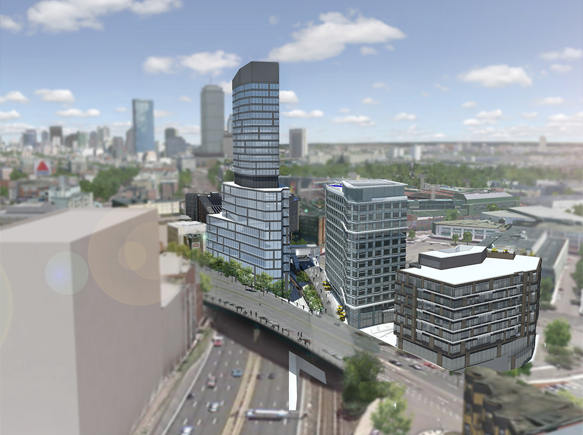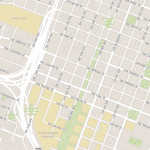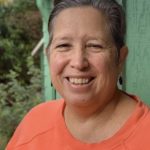
“[It’s] not just how do we create more buildable land to generate revenue for the city… it’s how do we hide this piece of infrastructure so that we can better unlock the city’s vibrancy?”
— Matt Edlen, Edlen & Company
On my continuing quest to learn more about freeway capping, I reached out to Portland-based developer Matt Edlen. Gerding Edlen Development was a joint partner in phase I of the Fenway Center, a big air-rights project in Boston, near Fenway Park, which will eventually span the Mass Turnpike. They’re also behind many of Portland’s most iconic development projects including South Waterfront, Brewery Blocks and others.
What are air-rights? When or if the Oregon Department of Transportation builds major caps over a freeway — which is being considered for the I-5 Rose Quarter project — they can lease the air-rights over the cap to a developer. The developer will then have the rights to build a building, but won’t own the land it sits atop. With freeway caps likely to be a part of our future, I wanted to know more about how they work and what the projects could entail.
Earlier this year, father and son Mark and Matt Edlen, along with two other co-founders, started a new company, Edlen & Co (the predecessor company, Gerding Edlen, rebranded as the Green Cities Company). Edlen & Co is broadening from their founders’ achievements as pioneers in sustainable development to focus on affordable housing and social services. They’re currently working with Albina Vision Trust and other groups on the housing and theater project we reported on back in January.
My conversation with Matt Edlen begins with a narrow focus on freeway capping, but quickly moves to the larger issues of urbanism, barriers, and unlocking the city’s vibrancy.
This interview was edited for clarity and brevity.
Advertisement
BikePortland: Help me think like a developer. What is it you look for when you’re deciding whether to take on an air rights project? What are the factors that play into that?
Edlen: I think that the biggest factor when it comes to air rights projects, in general, is there has to be a lot of upfront work done by all the parties that have purview and jurisdiction over the air rights themselves, you really need to make sure that people are 100% in communication and looking at it pragmatically—traffic management plans, staging plans.
The schedule is made, lost, broken, on transportation management and access plans. Without having that negotiated you’re dead in the water from the beginning.

BikePortland: Can you give me an idea of what our jurisdictions would be along I-405?
Edlen: Most of my experience has been in other markets, but here it is going to be ODOT, PBOT, City of Portland, Prosper Portland. It’s going to be the neighborhood—any sort of community/neighborhood overlays, they’re going to need to be involved.
BikePortland: It seems like you’re good at that, though. I’ve been looking through your projects.
Edlen: We enjoy—it’s complicated, and yes.
Right now we’re working on an affordable housing project over by the basketball stadium and the hospital (Rose Quarter and Legacy Hospital). In this case, you’ve got transportation management—and this is not an air rights deal—but still, you’re working with PBOT, ODOT, the city. This is where the state jurisdiction comes in, because you’re on an interstate. You just have a lot of contributing factors.
As long as you can get everyone to coalesce. For instance, in Boston, when we built Fenway Center, between our political reputation and our partner’s political reputation, both being very much in alignment with the city, very much stewards of community, that certainly sets a nice precedent and a nice tone for how we go in.
BikePortland: How reasonable are the DOTs with their air rights valuations, is that a big issue? The deal for the air rights for the second phase of the Fenway Center was recently closed with a $55 million valuation. (Edlen & Co was a developer of the Fenway Center’s first phase, which opened buildings in the fall of 2020.)
Edlen: That’s an interesting one too. This got really complicated. The way that the valuation for the air—we’re building the land, right? So, the air has value, but it’s only as tangible as the land that exists on there. And so, we were valuing based upon the net present value of the air, less the cost of the deck, which in this case was something that was going to be funded from the private side, from our side.
As we were going through the process, ultimately in assessing it, we determined that, if this is a viable solution, the better case scenario would be to have the land or the decking component built by the city. For a couple of reasons: one, you’re you’re dealing with your own inner agency. At that point, the central point of control isn’t coming from the private sector it’s coming from the public sector. That’s helpful. Two, typically the buying power from the city’s perspective and the ability to get things done is faster, and more cost effective.
There’s a lot of time involved in it. Let’s say I’m coming together with a project and I’m bringing together all the equity and all the debt, and we’re going to build a deck, and then we’re going to build a building. So let’s say—and this is just purely how developments get done—let’s say your return is based upon an internal rate of return (IRR) that is all subject to the time valuation of money. Well, if it takes me 18 to 24 months to build the deck, and then another 24 months to build a building on top of the deck, now we’re four years out on that. So that’s a big factor.
That right there is probably one of the biggest determining factors in how these things get done.
The second phase, which is under construction now—
BikePortland: Are you involved in that?
Edlen: I am not, no, and our predecessor company, Gerding Edlen which no longer exists, they became The Green Cities company, they are not as well. In many ways that was not necessarily a desire for us to not be involved, but from the standpoint of how that project moved forward, it was done with a partner who is going to be servicing a hundred percent of the debt and equity.
So the considerations around IRR weren’t a factor because for them, it’s a headquarters, it’s a long-term investment. So for them, that does make sense, and, if anything, that makes that project viable.
“Now you’ve got local capital that saying, this is my home. It can have a huge impact on making sure that we’re not displacing our community and displacing our tenants”
BikePortland: it sounds tremendously complicated.
Edlen: It is, but then take a step back. Looking at this from a 10,000 foot view, this is the absolute right thing to do. We have all this air and, especially in Portland where we’re not talking about a Mass Pike span—that’s a massive freeway. I-405 is a relatively small span.
It’s good urbanism. Unfortunately the infrastructure that make our cities work, when it’s exposed, does create barriers. And it does separate neighborhoods. And we can do something about that. That said, it does need a pragmatic view in in terms of making it work.

BikePortland: There is this idea of capping the whole freeway, but it seems to me that you could have a real impact on connectivity simply by breaching that barrier in a few strategic locations.
The southern end of I-405, by PSU (at right) — what a quagmire. Easier places might be near Burnisde or Yamhill. Are there spots on the I-405/I-5 loop that would be more attractive for a private developer to span than others?
Edlen: If we’re looking at what are the areas where you would kickoff a project, you’re totally right on those southwest corridors—Yamhill, Alder—I would say those make logically the most sense. Are there other opportunities? I think, yes, but from the standpoint of in-place economics today, relative to getting something off the ground to be your test case, that’s probably where I’d want to start.
BikePortland: Who initiates something like that?
Edlen: The City, Prosper Portland, one of those groups. Get the buzz around it, get some energy around this thing.
BikePortland: What would be an exciting building that would create a buzz?
Edlen: Affordable housing right now is very interesting because you have the dual consecutive bond measures that have allowed for the necessary gap funding. Between that and the federal government in the last round of stimulus which raised the value of the 4% tax credits, we’ve been really, really fortunate.
We’re building right now in conjunction with Albertina Kerr (an affordable housing project in Gresham). Because of the revised tax credit evaluation we were able to go net zero energy. It’s the fourth largest net zero energy affordable housing project ever built in the country. And that’s super exciting. So maybe there’s opportunity there.
I think what’s going to be the best project you have out there is something that is highly mixed use that is visible. If you’re going to do any sort of residential, include some affordable housing. I think that should be a mandate.
“It goes toward the notion of what are our barriers? What are the opportunities for the city to unlock its greater self?”
BikePortland: Is there something about the design of our city or how it’s been developed that has made us vulnerable to demonstrations that go on for months, and pockets where people are sleeping permanently? If you look at the southern end of downtown, I-405 cuts off residential areas from downtown, but the reverse is also true, it isolates downtown from residential areas and makes it desolate in the evening.
Edlen: Well, what’s interesting—and it’s ironic given the fact that it’s typically a place in most cities that brings people together — but the Park Blocks also create a barrier in their own right, when you think about it from the standpoint of going through the park at night. You’ve got the freeway on one side creating a barrier, you’ve got the school [PSU] which is—I bike a lot by the school, biking is the only way you can get anywhere over there, period. Otherwise it’s just, it’s a madhouse.

And then you start to move into the government buildings. That becomes a cold place to be. The streetscapes are very taut there, taut storefronts. There’s not a lot of articulation. The building scales are very large.
There was a movement probably ten years ago around establishing this whole creative corridor from the north park blocks to the south park blocks, and then through to the major cultural centers, and trying to bring new life.
I am on the symphony board and we were working together with Pioneer Courthouse Square to talk about activation strategies, which again help to counterbalance some of the things that you were noting that do make it a tougher place to be.
I think to your point, as we’ve seen this evolution especially over the past, I mean, it’s way in advance of the past 18 months, the past 18 months only exacerbated it. But as we’ve continued to see this kind of anti-Portland movement—I was born and raised here and I’m not letting that happen.
As the vibrancy feels like it’s dwindling at its core, that only makes those barriers higher.
BikePortland: Is Portland a good place to be developing now?
Edlen: It’s interesting. Our team is opening up from environmental sustainability into social sustainability and affordability. We’ve been doing that for years, but now really giving it the weight that it deserves.
So take, for example, a fund that I’ve been raising for the past few months, specifically acquiring existing vintage multifamily apartment product. Fifties, sixties, seventies, eighties deals, nineties deals. Where in-place rents are reflective of about 50 to 80% of area median income with the goal of improvements to the asset so that it can survive long-term, with the goal that we keep it affordable.
BikePortland: So financially, it’s a long-term investment, like owning a bond or something?
Edlen: Exactly. Now you’ve got local capital that saying, this is my home. It can have a huge impact on making sure that we’re not displacing our community and displacing our tenants.
But you still have folks coming in on the equity side going (spooky voice), “well, selling the Portland story …” even though we’re selling into solving a problem, recognizing that there’s this massive group of people who need good quality affordable housing, and this is not only improving the city, but you’ve got an entire pool of tenants that need this, where this is a real safe investment.
Going back to your initial thesis that embraces the infrastructure as a quotient of the public realm. Because I think that’s part of the biggest thing, not just how do we create more buildable land to generate revenue for the city—that’s a great by-product—it’s how do we hide this piece of infrastructure so that we can better unlock the city’s vibrancy?
I think this is a really great topic for this city. What’s interesting is that, big as it is in terms of its scale, it’s a very simple conversation that starts to address some of our problems.
It goes toward the notion of what are our barriers? What are the things that are keeping us disconnected from one another? What’s causing neighborhood segregation versus uniting the city? What are the opportunities for the city to unlock its greater self?
There is a point where the urbanism that makes sense at the time in hindsight may not be the best thing, but it’s our job as a city to continue to evolve and to continue to grow from that and to continue to explore what is going to make the city the best. And it’s going to change, and it’s going to change, and it’s going to change, as we as a community change and as our needs change.
And this is part of that conversation. So this is the right thing to be doing. This is the right thing to be kicking off.
BikePortland: You said you ride a bike, do you get around by bike?
Edlen: I do, oh yeah. My father got me turned onto cycling since when I was a child. He’s probably a minimum 30 to 40 miles in a day, upward of 60 to a hundred, big cyclist cyclist.
From a commuting standpoint, that’s the only way we get around. I live in North Portland and I can sneak onto the Williams-Vancouver freeway, of bikes, very easily.

— Lisa Caballero, lisacaballero853@gmail.com
— Get our headlines delivered to your inbox.
— Support this independent community media outlet with a one-time contribution or monthly subscription.

